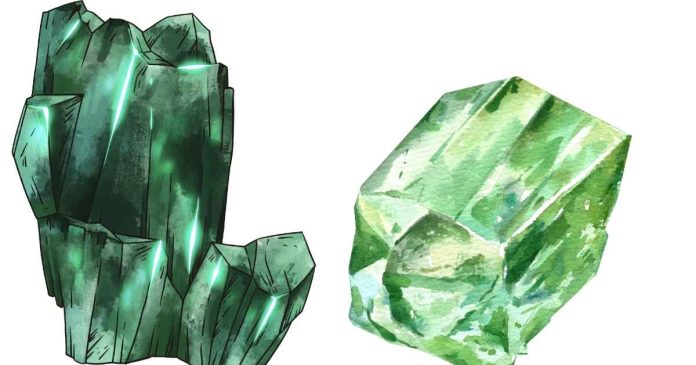1. Mineral Classification:
Emeralds are a variety of beryl, which is a beryllium aluminum silicate mineral (chemical formula: Be₃Al₂(SiO₃)₆). The term “beryl” refers to the larger family of minerals that includes various other gemstones, such as aquamarine (blue), morganite (pink), and heliodor (yellow).
2. Formation Process:
Emeralds are formed deep within the Earth’s crust, where heat and pressure cause beryl crystals to grow. This typically happens in hydrothermal veins—channels where mineral-rich fluids travel through cracks in the rock. Over millions of years, the right combination of temperature, pressure, and the presence of trace elements, such as chromium and vanadium, leads to the formation of emeralds.
3. Color and Composition:
What sets emeralds apart from other beryls is their green color. This color comes from the presence of trace amounts of chromium (Cr) and sometimes vanadium (V). The more chromium there is, the more intense the green, which is why high-quality emeralds are particularly valued for their deep, vibrant green.
- Chromium (Cr): Responsible for the vivid green color.
- Vanadium (V): Sometimes found alongside chromium, contributing to the color but less dominant.
- Iron (Fe): Trace amounts of iron can give the emerald a yellowish or bluish tint, but these tend to reduce the overall color quality.
4. Crystal Structure:
Emeralds are typically hexagonal in shape, as they belong to the hexagonal crystal system. This means they tend to form in a six-sided prismatic shape, though they are often found as rough, irregular crystals in nature.
5. Clarity and Inclusions:
Emeralds are famous for their inclusions, often referred to as “jardin” (French for “garden”), which are gas, liquid, or mineral inclusions trapped inside the crystal as it formed. While inclusions can affect the clarity, they are not necessarily seen as flaws—many people appreciate them for the character they give the stone. However, an emerald’s clarity and the absence of excessive inclusions are key factors in determining its value.
6. Hardness:
Emeralds, like other beryls, are relatively hard, with a Mohs hardness of 7.5 to 8. However, they are more brittle than other gems because of their inclusions, making them more prone to breaking or chipping if not handled carefully.
7. Geographical Origins:
Emeralds are found in several regions around the world, with the most famous sources being:
- Colombia: Known for producing some of the finest and most vivid green emeralds.
- Zambia: Known for producing emeralds with a deeper, bluish-green hue.
- Brazil: Another key source of emeralds, though the color and quality can vary.
- Other locations include Afghanistan, Zimbabwe, and Russia.
8. Uses:
Emeralds are primarily used in fine jewelry, including rings, necklaces, earrings, and bracelets. Due to their brittle nature, they’re often cut into shapes like ovals, cushions, or emerald cuts (a step-cut design) to minimize the risk of breakage.
9. Value Factors:
The value of an emerald is determined by several factors:
- Color: The most important factor, with the most prized emeralds being a rich, vivid green.
- Clarity: While inclusions are common and even expected in emeralds, those with fewer inclusions generally command higher prices.
- Cut: The quality and shape of the cut can impact both the appearance and the value of the stone.
- Carat weight: Larger emeralds are rarer and thus more valuable.
10. Historic and Cultural Significance:
Emeralds have been prized for thousands of years. Ancient civilizations like the Egyptians, Inca, and Aztecs considered emeralds sacred and used them in various jewelry and artifacts. They were associated with the goddess Venus and represented fertility, rebirth, and love.
Emeralds are an incredible natural phenomenon, combining beauty, geological complexity, and rich cultural history!


